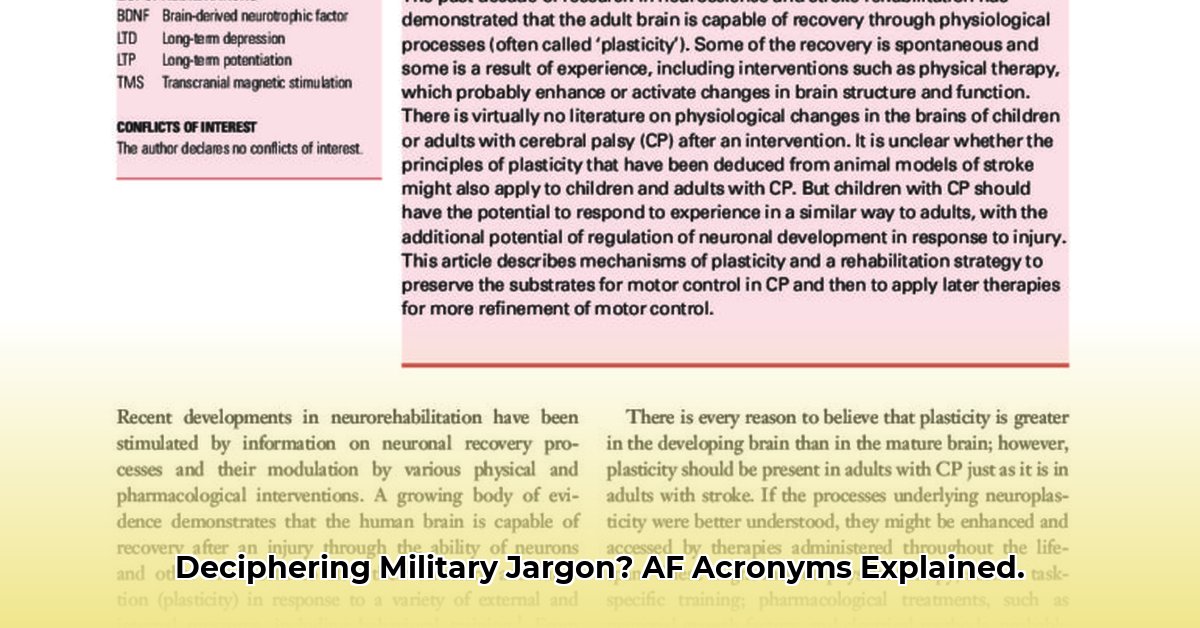Understanding Air Force terminology can feel like deciphering a secret code. With countless acronyms, it’s easy to get lost in the alphabet soup. This guide provides clarity, offering practical advice and resources for navigating the world of USAF abbreviations.
Understanding the AF Acronym Landscape
Finding a single, comprehensive list of all Air Force acronyms is unlikely. The reality is more nuanced. The Air Force, like other branches, operates within the broader Department of Defense (DOD) terminology framework. While individual units or specialties may have their own unique abbreviations, the authoritative source for official terms is the DoD Dictionary of Military and Associated Terms (JP 1-02).
Navigating the JP 1-02: Your Essential Resource (https://www.jcs.mil/Portals/36/Documents/Doctrine/pubs/jp1_02.pdf)
The JP 1-02 is the definitive guide for military terminology across all branches, replacing the former AFDD 1-2 as the primary reference for Air Force acronyms. This living document is regularly updated to reflect the evolving nature of military operations and technology. It’s readily accessible online as a searchable PDF.
How to Use the JP 1-02
- Access the Dictionary: Follow the link above to the official JP 1-02 PDF.
- Use Search Function: Utilize the search function (Ctrl+F or Cmd+F) to locate specific terms. Simply enter the acronym and the document will highlight all instances.
- Browse Alphabetically: If you’re unfamiliar with a specific term but know the general subject area, you can browse the document alphabetically.
Commonly Used Air Force Acronyms: A Quick Reference
While the JP 1-02 is comprehensive, a quick-reference list of commonly encountered acronyms can be helpful. This table provides a starting point, but always cross-reference with the JP 1-02 for official definitions.
| Acronym | Definition |
|---|---|
| AETC | Air Education and Training Command |
| AFMC | Air Force Materiel Command |
| AFSOC | Air Force Special Operations Command |
| ACC | Air Combat Command |
| AMC | Air Mobility Command |
| PACAF | Pacific Air Forces |
| AFGSC | Air Force Global Strike Command |
| AFRC | Air Force Reserve Command |
| ANG | Air National Guard |
| AFI | Air Force Instruction |
| AFSC | Air Force Specialty Code |
| TDY | Temporary Duty |
| PCS | Permanent Change of Station |
| JCS | Joint Chiefs of Staff |
(Downloadable PDF coming soon)
Deciphering Air Force Jargon: Beyond Acronyms
Understanding Air Force terminology goes beyond acronyms. It involves recognizing the nuances of abbreviations and initialisms.
- Acronyms: Pronounced as words (e.g., AWACS – “A-wacks”).
- Abbreviations: Shortened versions of words, pronounced as the shortened form (e.g., maint. for maintenance).
- Initialisms: Pronounced letter by letter (e.g., USAF – “U-S-A-F”).
Additional Resources
While the JP 1-02 serves as the primary resource, other helpful tools exist:
- DOD Dictionary: Provides definitions for terms used across the Department of Defense, offering broader context.
- Branch-Specific Glossaries: Each branch (Army, Navy, Marines, etc.) maintains its own lexicon. Consulting these resources can be valuable, especially in joint operations.
Importance of Accuracy
Precise language is paramount in the Air Force. Using correct terminology, especially in critical situations, ensures clarity, efficiency, and interoperability – ultimately contributing to mission success and safety. Misunderstandings stemming from informal jargon or outdated definitions can have serious consequences.
The Evolution of Language
Air Force language, like any other, is constantly evolving. New technologies, strategies, and even slang contribute to this ongoing development. Some research suggests slang fosters camaraderie, while others caution it can create communication barriers. It’s an area of ongoing study. Staying updated with the latest official terminology via the JP 1-02 is crucial.
Addressing Common Misunderstandings
The informal nature of slang and the lack of a single, all-encompassing dictionary can lead to misunderstandings. Terms like “Airman Snuffy,” “Chair Force,” or “House Mouse” can have varied interpretations depending on context and audience. Recognizing this potential for miscommunication is essential for effective communication.
Conclusion
Navigating Air Force terminology might seem daunting at first, but with the right resources and a focus on accuracy, it becomes manageable. Embrace the JP 1-02 as your guide, stay curious, and don’t hesitate to ask questions when encountering unfamiliar terms. Clear communication is the cornerstone of a successful and safe Air Force.
- Wind Energy Powered Cars: Are They the Future of Driving? - December 3, 2025
- Wind Energy in Cars: Is This the Future? - November 30, 2025
- Wind Energy For Residential: Is It Right For Your Home? - November 28, 2025
















